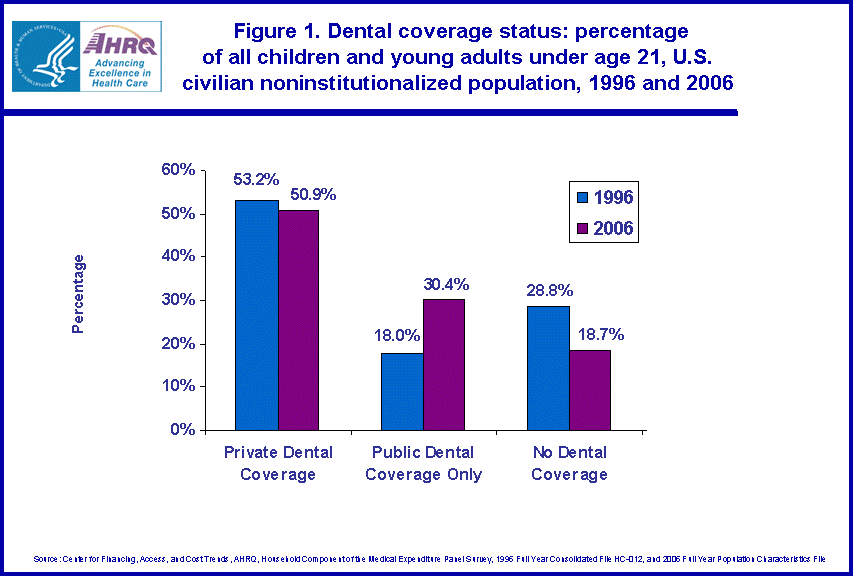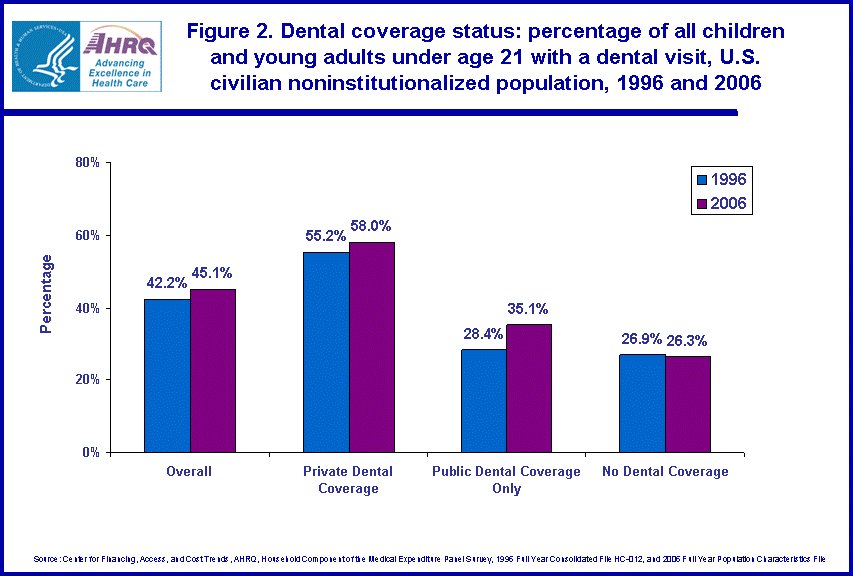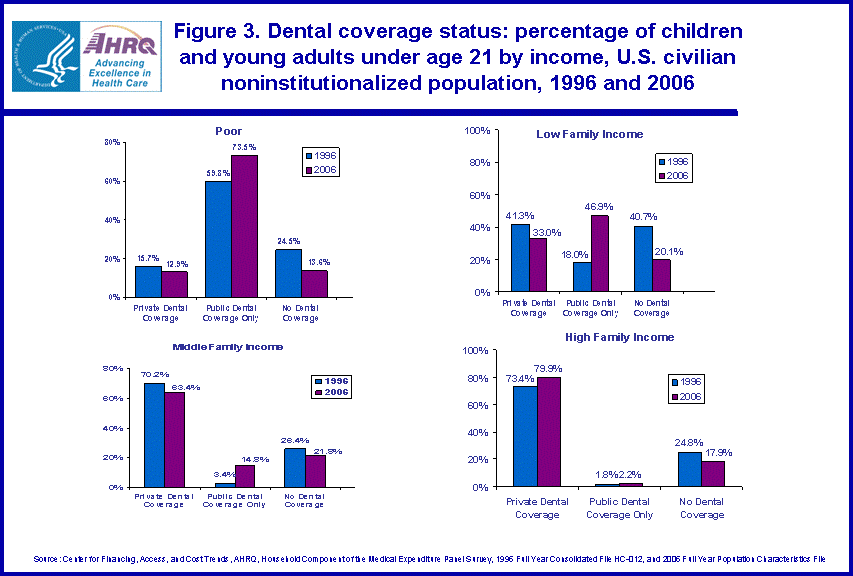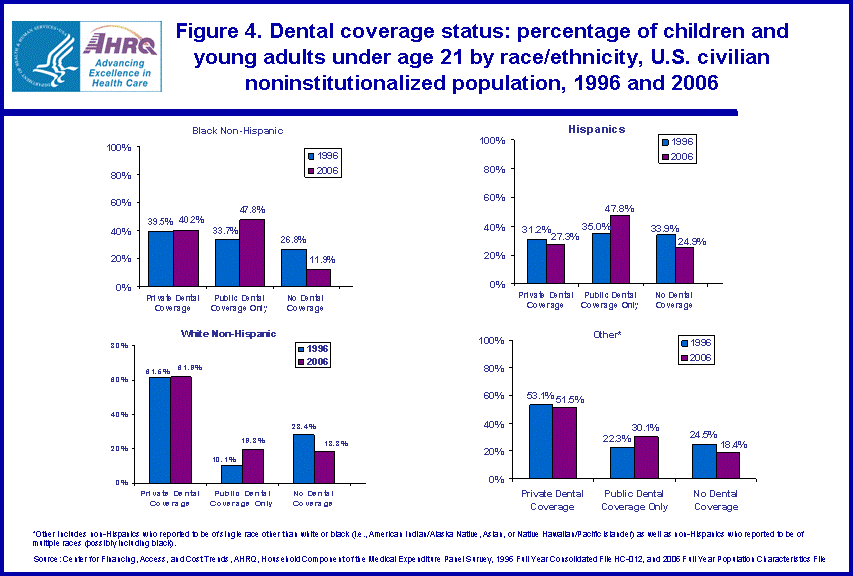
|
|
Font Size:
|
||||
|
|
|
|
||||
STATISTICAL BRIEF #221:
Dental Coverage of Children and Young Adults under Age 21, United States, 1996 and 2006
Highlights
- There was a significant increase in the percentage of children and young adults under 21 with public dental coverage only from 1996 to 2006.
- Poor, low, and middle income children and young adults under the age of 21 were much more likely to have public dental coverage only and less likely to have no dental coverage in 2006 than in 1996.
- In 2006, it was more likely for black non-Hispanic, Hispanic, and white non-Hispanic persons younger than 21 to have public dental coverage only, and less likely for them to have no dental coverage, than in 1996.
- A higher proportion of children and young adults under the age of 21 had at least one dental visit in 2006 than in 1996.
Introduction
This Statistical Brief presents estimates from the 1996 and 2006 Household Component of the Medical Expenditure Panel Survey (MEPS-HC). Moreover, this Brief provides data on the reported prevalence of dental coverage and the relationship of dental coverage to use for children and young adults age 0-20 living in the U.S. noninstitutionalized (community) population. MEPS-HC is an annual household survey sponsored by the Agency for Healthcare Research and Quality (AHRQ) and provides information useful for evaluating trends in dental care use and dental coverage status. In addition, this brief presents data from a period which corresponds with the enactment of the State Children's Health Insurance Program (SCHIP) and public dental coverage only extensions. Estimates are presented as the first in a series of updates to Chartbook 17: Dental Use, Expenses, Dental Coverage, and Changes, 1996 and 2004. Only differences that are statistically significant at the 0.05 level are discussed in the text.
Findings
In 2006, a higher percentage of children and young adults under 21 had public dental coverage only than in 1996 (figure 1). Additionally, a smaller percentage of children and young adults under age 21 had no dental coverage in 2006 than 1996.
During 2006, approximately 45.1 percent or 37.2 million children and young adults under the age of 21 in the United States had at least one dental visit, compared with approximately 42.2 percent or 34.8 million children and young adults under the age of 21 during 1996 (figure 2). The likelihood of having a dental visit for children and young adults under 21 with public dental coverage increased from 28.4 percent in 1996 to 35.1 percent in 2006. There was no significant change in the likelihood of having a dental visit during this period for those with no dental coverage.
Children and young adults under age 21 living in poor, low-income, and middle-income families were much more likely to have public dental coverage only, and less likely to have no dental coverage in 2006 than in 1996 (figure 3).
Children and young adults under age 21 living in high-income families were more likely to have private dental coverage in 2006 than in 1996 (79.9 percent vs. 73.4 percent), and less likely to have no dental coverage in 2006 than in 1996 (17.9 percent vs. 24.8 percent).
Black non-Hispanic, Hispanic, and white non-Hispanic children and young adults under 21 were much more likely to have public dental coverage only and less likely to have no dental coverage in 2006 than in 1996 (figure 4).
Data Source
Estimates shown in this Statistical Brief are drawn from analyses of the following public use files: 1996 Full Year Consolidated Data File HC-012, and 2006 Full Year Population Characteristics Data File HC-099.
Definitions
Dental visit
Dental visit refers to care by or visits to any type of dental care provider, including general dentists, dental hygienists, dental technicians, dental surgeons, orthodontists, endodontists, and periodontists.
Dental Coverage Variables
The variable for dental coverage indicates if a sample person was eligible to have payments made to a dental care provider on their behalf for dental care obtained during 1996 and 2006. For a detailed explanation of the dental coverage variables please see MEPS Chartbook No. 17 Definition of Terms, http://www.meps.ahrq.gov/mepsweb/data_files/publications/cb17/cb17.shtml.
Income
Income is expressed in terms of poverty status, the ratio of the family's income to the Federal poverty thresholds, which control for the size of the family and the age of the head of the family (see the 2006 U.S. Department of Health and Human Services Poverty Guidelines at http://www.aspe.hhs.gov/poverty/06poverty.shtml for more details). In this Brief, the following classification was used:
Poor: Persons in families with income less than or equal to 100% of the poverty line are considered poor. Some of these persons are in families reporting negative income.Population Characteristics
Low income: Persons in families with income over 100% through 200% of the poverty line are considered low income.
Middle income: Persons in families with income over 200% through 400% of the poverty line are considered middle income.
High income: Persons in families with income over 400% of the poverty line are considered high income.
In general, population characteristics were measured as of December 31st of the year of study (1996 or 2006), or the last date that the sample person was part of the civilian noninstitutionalized (community) population living in the United States prior to December 31st of that year.
Race/Ethnicity
Comparisons by race/ethnicity in this Chartbook are based on the following four race/ethnicity groups: black non-Hispanic, white non-Hispanic, Hispanic and other. Other includes non-Hispanics who reported to be of a single race other than white or black (i.e., American Indian/Alaska Native, Asian, or Native Hawaiian/Pacific Islander) as well as non-Hispanics who reported to be of multiple races (possibly including black).
About MEPS-HC
MEPS-HC is a nationally representative longitudinal survey that collects detailed information on health care utilization and expenditures, health insurance, and health status, as well as a wide variety of social, demographic, and economic characteristics for the civilian non-institutionalized population. It is cosponsored by the Agency for Healthcare Research and Quality and the National Center for Health Statistics.
For more information about MEPS, call the MEPS information coordinator at AHRQ (301-427-1656) or visit the MEPS Web site at http://www.meps.ahrq.gov/.
References
For a detailed description of the MEPS-HC survey design, sample design and methods used to minimize sources of nonsampling errors, see the following publications:
Cohen, J. Design and Methods of the Medical Expenditure Panel Survey Household Component. MEPS Methodology Report No. 1. AHCPR Pub. No. 97-0026. Rockville, MD: Agency for Health Care Policy and Research, 1997. http://www.meps.ahrq.gov/mepsweb/data_files/publications/mr1/mr1.shtml
Cohen, S. Sample Design of the 1996 Medical Expenditure Panel Survey Household Component. MEPS Methodology Report No. 2. AHCPR Pub. No. 97-0027. Rockville, MD: Agency for Health Care Policy and Research, 1997. http://www.meps.ahrq.gov/mepsweb/data_files/publications/mr2/mr2.shtml
Cohen, S. Design Strategies and Innovations in the Medical Expenditure Panel Survey. Medical Care, July 2003: 41(7) Supplement: III-5-III-12.
Ezzati-Rice, TM, Rhode, F, Greenblatt J. Sample Design of the Medical Expenditure Panel Survey Household Component, 1998-2007. Methodology Report No. 22. March 2008. Agency for Health Care Research and Quality, Rockville, MD. http://www.meps.ahrq.gov/mepsweb/data_files/publications/mr22/mr22.shtml
Manski, R.J. Brown, E. Dental Use, Expenses, Private Dental Coverage, and Changes, 1996 and 2004. Rockville, (MD): Agency for Health Care Research and Quality, 2007. MEPS Chartbook No.17. http://www.meps.ahrq.gov/mepsweb/data_files/publications/cb17/cb17.shtml
Suggested Citation
Manski, R.J. and Brown, E. Dental Coverage of Children and Young Adults under Age 21, United States, 1996 and 2006. Statistical Brief #221. September 2008. Agency for Health Care Research and Quality, Rockville. MD, http://www.meps.ahrq.gov/mepsweb/data_files/publications/st221/stat221.shtml
AHRQ welcomes questions and comments from readers of this publication who are interested in obtaining more information about access, cost, use, financing, and quality of health care in the United States. We also invite you to tell us how you are using this Statistical Brief and other MEPS data and tools and to share suggestions on how MEPS products might be enhanced to further meet your needs. Please e-mail us at mepspd@ahrq.gov or send a letter to the address below:
Steven B. Cohen, PhD, Director
Center for Financing, Access, and Cost Trends
Agency for Healthcare Research and Quality
540 Gaither Road
Rockville, MD 20850
 |
||||||||||||||||||||||||||||||||||||||||||||||||||||||||||||||||
Source: Center for Financing, Access, and Cost Trends, AHRQ, Household Component of the Medical Expenditure Panel Survey, 1996 Full Year Consolidated File HC-012, and 2006 Full Year Population Characteristics File | ||||||||||||||||||||||||||||||||||||||||||||||||||||||||||||||||
|
|
||||||||||||||||||||||||||||||||||||||||||||||||||||||||||||||||
 |
||||||||||||||||||||||||||||||||||||||||||||||||||||||||||||||||
Source: Center for Financing, Access, and Cost Trends, AHRQ, Household Component of the Medical Expenditure Panel Survey, 1996 Full Year Consolidated File HC-012, and 2006 Full Year Population Characteristics File | ||||||||||||||||||||||||||||||||||||||||||||||||||||||||||||||||
|
|
||||||||||||||||||||||||||||||||||||||||||||||||||||||||||||||||
 |
||||||||||||||||||||||||||||||||||||||||||||||||||||||||||||||||
Source: Center for Financing, Access, and Cost Trends, AHRQ, Household Component of the Medical Expenditure Panel Survey, 1996 Full Year Consolidated File HC-012, and 2006 Full Year Population Characteristics File
Source: Center for Financing, Access, and Cost Trends, AHRQ, Household Component of the Medical Expenditure Panel Survey, 1996 Full Year Consolidated File HC-012, and 2006 Full Year Population Characteristics File
Source: Center for Financing, Access, and Cost Trends, AHRQ, Household Component of the Medical Expenditure Panel Survey, 1996 Full Year Consolidated File HC-012, and 2006 Full Year Population Characteristics File |
||||||||||||||||||||||||||||||||||||||||||||||||||||||||||||||||
|
|
||||||||||||||||||||||||||||||||||||||||||||||||||||||||||||||||
 |
||||||||||||||||||||||||||||||||||||||||||||||||||||||||||||||||
Source: Center for Financing, Access, and Cost Trends, AHRQ, Household Component of the Medical Expenditure Panel Survey, 1996 Full Year Consolidated File HC-012, and 2006 Full Year Population Characteristics File
Source: Center for Financing, Access, and Cost Trends, AHRQ, Household Component of the Medical Expenditure Panel Survey, 1996 Full Year Consolidated File HC-012, and 2006 Full Year Population Characteristics File
Source: Center for Financing, Access, and Cost Trends, AHRQ, Household Component of the Medical Expenditure Panel Survey, 1996 Full Year Consolidated File HC-012, and 2006 Full Year Population Characteristics File
*Other includes non-Hispanics who reported to be of single race other than white or black (i.e., American Indian/Alaska Native, Asian, or Native Hawaiian/Pacific Islander) as well as non-Hispanics who reported to be of multiple races (possibly including black).
|
||||||||||||||||||||||||||||||||||||||||||||||||||||||||||||||||
|
|
||||||||||||||||||||||||||||||||||||||||||||||||||||||||||||||||


